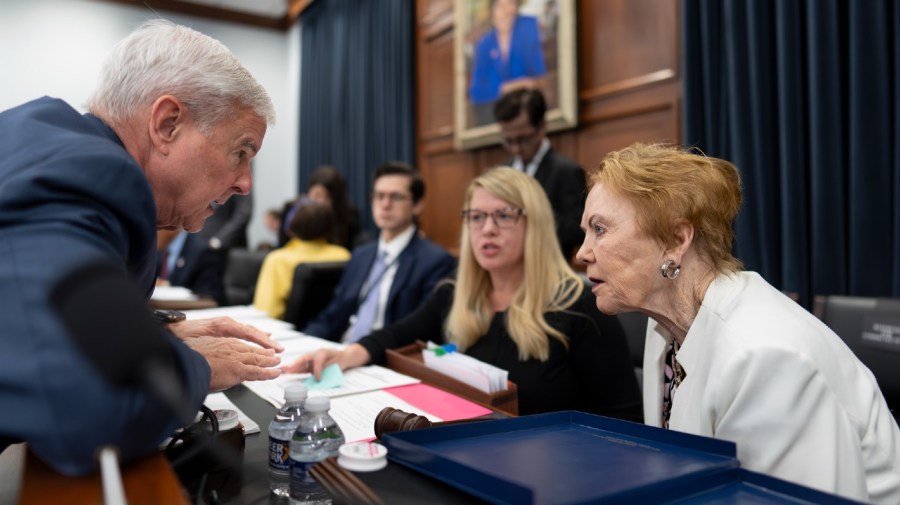Business
Frustration emerges among GOP spending ‘cardinals’ as conservatives push for cuts on July 30, 2023 at 10:00 am Business News | The Hill

The House Republicans who craft the conference’s government funding bills are showing signs of frustration as hard-line conservatives pressure leadership for further cuts to spending that some worry could be too aggressive.
Some of the 12 Appropriations subcommittee chairs — the so-called cardinals — told reporters that they are struggling to see where those additional cuts could come from, as September’s shutdown deadline looms.
“I just don’t see the wisdom in trying to further cut to strengthen our hand. I don’t know how that strengthens our hand,” Rep. Steve Womack (R-Ark.), a House Appropriations subcommittee chairman, said of conservatives’ push to further cut the already-scaled-back spending bills.
“I do think it puts some of our members in a very difficult spot, particularly those in tough districts, because they’re going to be taking some votes that become problematic,” he added.
The House left Washington for a long summer recess Thursday after being forced to punt a bill to fund agriculture and the Food and Drug Administration.
Conservatives are dug in on their demand for steeper spending cuts, to the chagrin of moderates who are wary of slashing funding even more. The chamber has passed just one appropriations bill, funding military construction and the Department of Veterans Affairs.
The internal divisions are gripping the party as time is running out: The House has just 12 days in September to move the remaining 11 appropriations measures and hash out their disagreements with the Senate, which is marking up its spending bills at higher levels, setting the scene for a hectic fall that could bring the U.S. to the brink of a shutdown.
Those dynamics are putting GOP appropriators in a bind, leaving them searching for ways to appease conservative requests without gutting their spending bills.
“We’ve done a lot of cuts, a lot of cuts,” House Appropriations Committee Chairwoman Kay Granger (R-Texas) told The Hill this week. “And so if it’s cuts just for cut’s sake, I don’t agree with it. But if it’s something that we can do without, that’s fine.”
‘Not a lot of wiggle room left’
Republican appropriators in the House announced earlier this year that they would mark up their bills for fiscal 2024 at fiscal 2022 levels, as leaders sought to placate conservatives who thought the debt ceiling deal struck by President Biden and Speaker Kevin McCarthy (R-Calif.) earlier this year didn’t do enough to curb spending.
The Senate is crafting its bills more in line with the budget caps agreed to in the deal, but House Republicans are already fuming about a bipartisan deal in the upper chamber that would allow for more than $13 billion in additional emergency spending on top of those levels.
House GOP negotiators also said they would pursue clawing back more than $100 billion in old funding that was allocated for Democratic priorities without GOP support in the previous Congress.
While that move drew support from hard-line conservatives, the right flank was far from pleased when it heard appropriators planned to repurpose that old funding — known as rescissions — to plus-up the spending bills.
In a letter to McCarthy earlier this month, a group of hard-line conservatives called for all 12 appropriations bills to be in line with fiscal 2022 spending levels “without the use of reallocated rescissions to increase discretionary spending above that top-line.”
Otherwise, the 21 lawmakers threatened, they would vote against the measures. But that request could prove difficult for GOP appropriators to fulfill.
Rep. Mario Diaz-Balart (R-Fla.), chairman of the panel that proposes funding for the Department of State and foreign operations, said that appropriators are already “dramatically reducing spending,” suggesting that there are not too many remaining areas to trim from.
“My bill is below the 2016 levels,” he said, later adding, “When you’re below the 2016 level — and we’re still confronting China — I think there’s not a lot of wiggle room left.”
“It’s a challenge, but I think we’ll get through it. I really do,” he added.
Rep. Mike Simpson (R-Idaho), who heads the subcommittee that oversees funding for the Environmental Protection Agency and the Department of Interior, scoffed at the idea of even steeper cuts to his bill.
“Then you just drop it on the floor and stomp on it. What else do you do with it?” he told reporters. “You can’t make logical cuts in there.”
Republicans appropriators are voicing optimism that the conference will be able to sort out its differences on spending, but some also hope their levels will stick — even though they include rescissions.
Rep. Chuck Fleischmann (R-Tenn.) — whose panel handles funding for the Department of Energy, which is proposing offsetting billions of dollars in spending with clawbacks — said it would be “extremely difficult” to craft his bill without the rescinded funds.
“And given our priorities in my bill, national defense with the nuclear weapons portfolio, nuclear cleanup, Army Corps including, all the community-directed fundings, I feel good about my bill, and I hope my numbers hold,” he said.
“Because it’s gonna have to be in negotiations with the Senate and the White House as well,” he added.
Womack — whose subcommittee crafts funding for the IRS and the Treasury Department — said he doesn’t think “moving the goalposts on these numbers is helpful in strengthening our ability to negotiate with the Senate.”
August preparations for a busy September
Frustrations among appropriators are bubbling up as Congress inches closer to the fall, when lawmakers are facing a Sept. 30 deadline to approve funding or risk a government shutdown.
With time running out, some House lawmakers say conversations may continue over the long August recess to try to hash out remaining differences.
“We’ll have to see,” Rep. Chip Roy (R-Texas) said when asked about potential plans for talks between leaders and House Freedom Caucus members over the break. “I mean, we got a lot of work to do.”
“I think a lot of work [has] got to be done behind the scenes,” he said. “If not, you know, here — You gotta beg the question about whether we should be gone for six weeks. We should be getting our job done.”
Rep. Bob Good (R-Va.) echoed that sentiment, saying “I would think so” when asked if lawmakers will have conversations over the break.
Adding to the August workload, House Majority Leader Steve Scalise (R-La.) suggested earlier this week that bicameral negotiations could take place over the weeks-long recess as lawmakers stare down the shutdown deadline.
Not all Republicans, however, are viewing a shutdown as a risk.
During a House Freedom Caucus press conference this week, Good said “we should not fear a government shutdown,” claiming that “most of what we do up here is bad anyway; most of what we do up here hurts the American people.”
But that perspective does not jive with the view of McCarthy, who declared Thursday: “I don’t want the government to shut down.”
Multiple Republicans are ultimately expecting Congress to eventually pass what’s known as a continuing resolution (CR), or a measure that temporarily allows the government to be funded at the previous fiscal year’s levels, to prevent a lapse at the end of September.
But they also understand the task could be difficult in the GOP-led chamber, where Republicans aren’t happy about the idea of continuing funding at the current levels — which were last set when Democrats held control of Congress.
“I think there’s a very good chance that we’ll see a CR, but I know there’s a lot of work to get a CR done,” Rep. Robert Aderholt (R-Ala.), another appropriator, said Thursday, noting there are “a lot of members that don’t want CRs that are tired of them.”
But Aderholt suggested a CR could notch sufficient GOP backing if there’s a larger plan in sight that the party can support.
“The Speaker’s been very good about having a plan,” he said, adding, “I think that’s what he’s good at, and I’m optimistic that he can come up with something.”
Emily Brooks contributed.
House, Appropriations, Business, News The House Republicans who craft the conference’s government funding bills are showing signs of frustration as hard-line conservatives pressure leadership for further cuts to spending that some worry could be too aggressive. Some of the 12 Appropriations subcommittee chairs — the so-called cardinals — told reporters that they are struggling to see where those additional cuts…
Business
Google Accused Of Favoring White, Asian Staff As It Reaches $28 Million Deal That Excludes Black Workers

Google has tentatively agreed to a $28 million settlement in a California class‑action lawsuit alleging that white and Asian employees were routinely paid more and placed on faster career tracks than colleagues from other racial and ethnic backgrounds.
- A Santa Clara County Superior Court judge has granted preliminary approval, calling the deal “fair” and noting that it could cover more than 6,600 current and former Google workers employed in the state between 2018 and 2024.

How The Discrimination Claims Emerged
The lawsuit was brought by former Google employee Ana Cantu, who identifies as Mexican and racially Indigenous and worked in people operations and cloud departments for about seven years. Cantu alleges that despite strong performance, she remained stuck at the same level while white and Asian colleagues doing similar work received higher pay, higher “levels,” and more frequent promotions.
Cantu’s complaint claims that Latino, Indigenous, Native American, Native Hawaiian, Pacific Islander, and Alaska Native employees were systematically underpaid compared with white and Asian coworkers performing substantially similar roles. The suit also says employees who raised concerns about pay and leveling saw raises and promotions withheld, reinforcing what plaintiffs describe as a two‑tiered system inside the company.
Why Black Employees Were Left Out
Cantu’s legal team ultimately agreed to narrow the class to employees whose race and ethnicity were “most closely aligned” with hers, a condition that cleared the path to the current settlement.

The judge noted that Black employees were explicitly excluded from the settlement class after negotiations, meaning they will not share in the $28 million payout even though they were named in earlier versions of the case. Separate litigation on behalf of Black Google employees alleging racial bias in pay and promotions remains pending, leaving their claims to be resolved in a different forum.
What The Settlement Provides
Of the $28 million total, about $20.4 million is expected to be distributed to eligible class members after legal fees and penalties are deducted. Eligible workers include those in California who self‑identified as Hispanic, Latinx, Indigenous, Native American, American Indian, Native Hawaiian, Pacific Islander, and/or Alaska Native during the covered period.
Beyond cash payments, Google has also agreed to take steps aimed at addressing the alleged disparities, including reviewing pay and leveling practices for racial and ethnic gaps. The settlement still needs final court approval at a hearing scheduled for later this year, and affected employees will have a chance to opt out or object before any money is distributed.
H2: Google’s Response And The Broader Stakes
A Google spokesperson has said the company disputes the allegations but chose to settle in order to move forward, while reiterating its public commitment to fair pay, hiring, and advancement for all employees. The company has emphasized ongoing internal audits and equity initiatives, though plaintiffs argue those efforts did not prevent or correct the disparities outlined in the lawsuit.
For many observers, the exclusion of Black workers from the settlement highlights the legal and strategic complexities of class‑action discrimination cases, especially in large, diverse workplaces. The outcome of the remaining lawsuit brought on behalf of Black employees, alongside this $28 million deal, will help define how one of the world’s most powerful tech companies is held accountable for alleged racial inequities in pay and promotion.
Business
Luana Lopes Lara: How a 29‑Year‑Old Became the Youngest Self‑Made Woman Billionaire

At just 29, Luana Lopes Lara has taken a title that usually belongs to pop stars and consumer‑app founders.
Multiple business outlets now recognize her as the world’s youngest self‑made woman billionaire, after her company Kalshi hit an 11 billion dollar valuation in a new funding round.
That round, a 1 billion dollar Series E led by Paradigm with Sequoia Capital, Andreessen Horowitz, CapitalG and others participating, instantly pushed both co‑founders into the three‑comma club. Estimates place Luana’s personal stake at roughly 12 percent of Kalshi, valuing her net worth at about 1.3 billion dollars—wealth tied directly to equity she helped create rather than inheritance.

Kalshi itself is a big part of why her ascent matters.
Founded in 2019, the New York–based company runs a federally regulated prediction‑market exchange where users trade yes‑or‑no contracts on real‑world events, from inflation reports to elections and sports outcomes.
As of late 2025, the platform has reached around 50 billion dollars in annualized trading volume, a thousand‑fold jump from roughly 300 million the year before, according to figures cited in TechCrunch and other financial press. That hyper‑growth convinced investors that event contracts are more than a niche curiosity, and it is this conviction—expressed in billions of dollars of new capital—that turned Luana’s share of Kalshi into a billion‑dollar fortune almost overnight.
Her path to that point is unusually demanding even by founder standards. Luana grew up in Brazil and trained at the Bolshoi Theater School’s Brazilian campus, where reports say she spent up to 13 hours a day in class and rehearsal, competing for places in a program that accepts fewer than 3 percent of applicants. After a stint dancing professionally in Austria, she pivoted into academics, enrolling at the Massachusetts Institute of Technology to study computer science and mathematics and later completing a master’s in engineering.
During summers she interned at major firms including Bridgewater Associates and Citadel, gaining a front‑row view of how global macro traders constantly bet on future events—but without a simple, regulated way for ordinary people to do the same.

That realization shaped Kalshi’s founding thesis and ultimately her billionaire status. Together with co‑founder Tarek Mansour, whom she met at MIT, Luana spent years persuading lawyers and U.S. regulators that a fully legal event‑trading exchange could exist under commodities law. Reports say more than 60 law firms turned them down before one agreed to help, and the company then spent roughly three years in licensing discussions with the Commodity Futures Trading Commission before gaining approval. The payoff is visible in 2025’s numbers: an 11‑billion‑dollar valuation, a 1‑billion‑dollar fresh capital injection, and a founder’s stake that makes Luana Lopes Lara not just a compelling story but a data point in how fast wealth can now be created at the intersection of finance, regulation, and software.
Business
Harvard Grads Jobless? How AI & Ghost Jobs Broke Hiring

America’s job market is facing an unprecedented crisis—and nowhere is this more painfully obvious than at Harvard, the world’s gold standard for elite education. A stunning 25% of Harvard’s MBA class of 2025 remains unemployed months after graduation, the highest rate recorded in university history. The Ivy League dream has become a harsh wakeup call, and it’s sending shockwaves across the professional landscape.

Jobless at the Top: Why Graduates Can’t Find Work
For decades, a Harvard diploma was considered a golden ticket. Now, graduates send out hundreds of résumés, often from their parents’ homes, only to get ghosted or auto-rejected by machines. Only 30% of all 2025 graduates nationally have found full-time work in their field, and nearly half feel unprepared for the workforce. “Go to college, get a good job“—that promise is slipping away, even for the smartest and most driven.
Tech’s Iron Grip: ATS and AI Gatekeepers
Applicant tracking systems (ATS) and AI algorithms have become ruthless gatekeepers. If a résumé doesn’t perfectly match the keywords or formatting demanded by the bots, it never reaches human eyes. The age of human connection is gone—now, you’re just a data point to be sorted and discarded.
AI screening has gone beyond basic qualifications. New tools “read” for inferred personality and tone, rejecting candidates for reasons they never see. Worse, up to half of online job listings may be fake—created simply to collect résumés, pad company metrics, or fulfill compliance without ever intending to fill the role.
The Experience Trap: Entry-Level Jobs Require Years
It’s not just Harvard grads who are hurting. Entry-level roles demand years of experience, unpaid internships, and portfolios that resemble a seasoned professional, not a fresh graduate. A bachelor’s degree, once the key to entry, is now just the price of admission. Overqualified candidates compete for underpaid jobs, often just to survive.
One Harvard MBA described applying to 1,000 jobs with no results. Companies, inundated by applications, are now so selective that only those who precisely “game the system” have a shot. This has fundamentally flipped the hiring pyramid: enormous demand for experience, shrinking chances for new entrants, and a brutal gauntlet for anyone not perfectly groomed by internships and coaching.
Burnout Before Day One
The cost is more than financial—mental health and optimism are collapsing among the newest generation of workers. Many come out of elite programs and immediately end up in jobs that don’t require degrees, or take positions far below their qualifications just to pay the bills. There’s a sense of burnout before careers even begin, trapping talent in a cycle of exhaustion, frustration, and disillusionment.
Cultural Collapse: From Relationships to Algorithms
What’s really broken? The culture of hiring itself. Companies have traded trust, mentorship, and relationships for metrics, optimizations, and cost-cutting. Managers no longer hire on potential—they rely on machines, rankings, and personality tests that filter out individuality and reward those who play the algorithmic game best.
AI has automated the very entry-level work that used to build careers—research, drafting, and analysis—and erased the first rung of the professional ladder for thousands of new graduates. The result is a workforce filled with people who know how to pass tests, not necessarily solve problems or drive innovation.
The Ghost Job Phenomenon
Up to half of all listings for entry-level jobs may be “ghost jobs”—positions posted online for optics, compliance, or future needs, but never intended for real hiring. This means millions of job seekers spend hours on applications destined for digital purgatory, further fueling exhaustion and cynicism.
Not Lazy—Just Locked Out
Despite the headlines, the new class of unemployed graduates is not lazy or entitled—they are overqualified, underleveraged, and battered by a broken process. Harvard’s brand means less to AI and ATS systems than the right keyword or résumé format. Human judgment has been sidelined; individuality is filtered out.

What’s Next? Back to Human Connection
Unless companies rediscover the value of human potential, mentorship, and relationships, the job search will remain a brutal numbers game—one that even the “best and brightest” struggle to win. The current system doesn’t just hurt workers—it holds companies back from hiring bold, creative talent who don’t fit perfect digital boxes.
Key Facts:
- 25% of Harvard MBAs unemployed, highest on record
- Only 30% of 2025 grads nationwide have jobs in their field
- Nearly half of grads feel unprepared for real work
- Up to 50% of entry-level listings are “ghost jobs”
- AI and ATS have replaced human judgment at most companies
If you’ve felt this struggle—or see it happening around you—share your story in the comments. And make sure to subscribe for more deep dives on the reality of today’s economy and job market.
This is not just a Harvard problem. It’s a sign that America’s job engine is running on empty, and it’s time to reboot—before another generation is locked out.

 Entertainment2 weeks ago
Entertainment2 weeks agoWicked Sequel Disappoints Fans: Audience Verdict on For Good

 News3 weeks ago
News3 weeks agoYolanda Adams Questions Traditional Views on God’s Gender, Audience Reacts

 Entertainment2 weeks ago
Entertainment2 weeks agoAriana & Cynthia Say They’re in a ‘Non‑Demi Curious, Semi‑Binary’ Relationship… WTF Does That Even Mean?

 News3 weeks ago
News3 weeks agoEpstein Files to Be Declassified After Trump Order

 News4 weeks ago
News4 weeks agoTrump Throws Epstein Files at Clinton’s Door

 Entertainment4 weeks ago
Entertainment4 weeks agoAriana Grande’s Red Carpet: When Fans Forget Boundaries

 Entertainment4 weeks ago
Entertainment4 weeks agoKim Kardashian Reportedly Scammed by Psychic Before Failing Bar Exam

 Entertainment3 weeks ago
Entertainment3 weeks agoHollywood’s Kiss or Miss Policy: Why Saying No Got Neal McDonough Blackballed




























